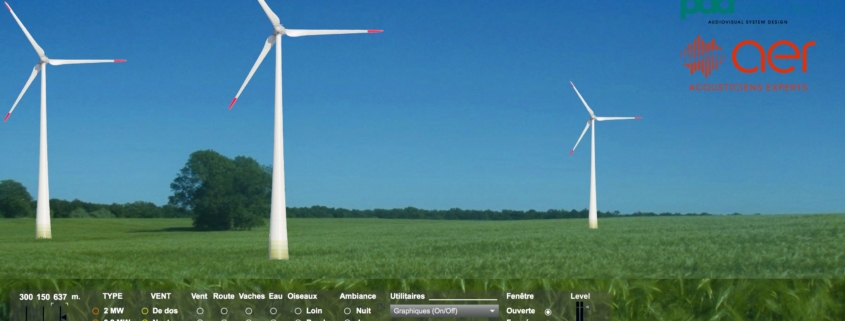
wind farm sound simulator
WFSS, Wind Turbine Sound Simulation, is a joint project by AER Acousticiens Experts and PAA Consulting.
The normative aspects, qualification and definitions of the simulation values were defined by AER, while the audio engine, the symbolic graphical interface and the programming made by PAA Consulting. All validated by the LEMA, acoustics department of EPFL Lausanne.
Originally created on behalf of a corporate customer, this OSX / Windows software tool is designed to provide a common language and repositories for pros and opponents of wind farms projects, to enable them to communicate in a dispassionate manner based on objective criteria. The interface is designed to evoke a familiar environment and offers elements of comparison and orders of magnitude that allow an appreciation of reliable and representative sound based on real life examples, all the while minimising the use of numerical values expressed in dB as these often are abstract and confusing for non-specialists. For guests, the technical side only implies that would they listen to is thorough rendered of an example wind farm, complete with typical country side noise sources including, cows, streams, wind, birds and roads. This gives users a mean of putting wind farm sounds into a familiar context.
So, WFSS in order to remain technically transparent and technical unobtrusive to the understanding of a situation, was created to be extremely user friendly and simple on the outside, to the extend of having the basic controls shown above designed to be nested on a second operator screen , whereas the main page would only show pictures of the common graphical objects.
On the inside of the software, things get highly technical and intricately detailed in terms of acoustical simulation based on thorough field measurements and calculations:
Future possible developments include a 3d version based on Unity game engine. Since all the proper sound definitions for varying sound situations already have been calculated, sorting the audio side to the Ambisonics ready audio engine of Unity is easy theoretically. Of course, the visual side can be refined to further degrees of details and on this side, as in a regular video game, the sky is the limit…
The idea of a movable demonstrator, a 3D ready environment in a truck also floated around, basically a hardware version of the Unity engine 3d. That would of course be imminently practical and efficient for small group presentations on location, as the audio system could be finely calibrated from scratch. Albeit, we agree, a tad on the expensive side. But so was the orignal intend and demand form original customer: creating real life 1.1 scale of the sound simulator on location. This would have implied to create one or more 100 meter high sound sources, exhibiting wind turbine size sound behaviour, taking wind orientation and speed parameters into account for generating adequate noise and correct distances, height and size.
download white paper
This post is also available in: French


